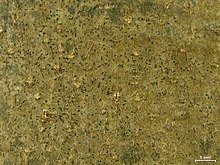Opegraphaceae is a family of lichen-forming and lichenicolous fungi in the order Arthoniales.[1] It was originally proposed by German lichenologist Ernst Stizenberger in 1862.[2] It fell into disuse, but was resurrected in a molecular phylogenetic study of the order Arthoniales published in 2010. It now includes taxa that were previously referred to the family Roccellaceae, its sister group.[3]
| Opegraphaceae | |
|---|---|

| |
| Opegrapha vulgata | |
| Scientific classification | |
| Domain: | Eukaryota |
| Kingdom: | Fungi |
| Division: | Ascomycota |
| Class: | Arthoniomycetes |
| Order: | Arthoniales |
| Family: | Opegraphaceae Stizenb. (1862) |
| Type genus | |
| Opegrapha Ach. (1809)
| |
Description
editMost taxa in the family have a crustose thallus, although in rare cases it is fruticose. The lichens typically grow on bark, wood, or rocks. Some members, such as those in the genus Fouragea, grow on leaves. The family has a cosmopolitan distribution, but is predominant in tropical and semi-arid subtropical regions. The photobiont partner of Opegraphaceae is a member of the green algal genus Trentepohlia.[4]
A variety of secondary chemicals have been identified in this family. The most common types are depsides, depsidones, dibenzofurans, and anthraquinones.[4]
Genera
editAs of March 2021[update], Species Fungorum accepts 15 genera and 167 species in the family Opegraphaceae.[5] This is a list of the genera in the Opegraphaceae based on a 2020 review and summary of fungal classification by Wijayawardene and colleagues.[1] Following the genus name is the taxonomic authority (those who first circumscribed the genus; standardized author abbreviations are used), year of publication, and the number of species:
- Combea De Not. (1846) – 2 spp.
- Cresponea Egea & Torrente (1993)[6] – 22 spp.
- Dictyographa Müll.Arg. (1893) – 2 spp.
- Dolichocarpus R.Sant. (1949)[7] – 2 spp.
- Fouragea Trevis. (1880) – 4 spp.
- Ingaderia Darb. (1897)[8] – 3 spp.
- Nyungwea Sérus., Eb.Fisch. & Killmann (2006) – 3
- Opegrapha Ach. (1809) – ca. 100 + ca. 200 orphaned
- Paraingaderia Ertz & Tehler (2011)[3] – 1 sp.
- Paralecanographa Ertz & & Tehler (2011)[3] – 1 sp.
- Paraschismatomma Ertz & Tehler (2011)[3] – 1 sp.
- Pentagenella Darb. (1897) – 5 spp.
- Schizopelte Th.Fr. (1875)[9] – 4 spp.
- Sclerophyton Eschw. (1824) – ca. 15 spp.
- Sparria Ertz & Tehler (2011)[3] – 2 spp.
References
edit- ^ a b Wijayawardene, Nalin; Hyde, Kevin; Al-Ani, Laith Khalil Tawfeeq; Somayeh, Dolatabadi; Stadler, Marc; Haelewaters, Danny; et al. (2020). "Outline of Fungi and fungus-like taxa". Mycosphere. 11: 1060–1456. doi:10.5943/mycosphere/11/1/8. hdl:10481/61998.
- ^ Stizenberger, E. (1862). "Beitrag zur Flechtensystematik". Bericht über die Tätigkeit der St. Gallischen Naturwissenschaftlichen Gesellschaft (in German). 1861–1862: 124–182.
- ^ a b c d e Ertz, Damien; Tehler, Anders (2010). "The phylogeny of Arthoniales (Pezizomycotina) inferred from nucLSU and RPB2 sequences". Fungal Diversity. 49 (1): 47–71. doi:10.1007/s13225-010-0080-y.
- ^ a b Jaklitsch, Walter; Baral, Hans-Otto; Lücking, Robert; Lumbsch, H. Thorsten (2016). Frey, Wolfgang (ed.). Syllabus of Plant Families: Adolf Engler's Syllabus der Pflanzenfamilien. Vol. 1/2 (13 ed.). Berlin Stuttgart: Gebr. Borntraeger Verlagsbuchhandlung, Borntraeger Science Publishers. pp. 42–44. ISBN 978-3-443-01089-8. OCLC 429208213.
- ^ Species Fungorum. "Opegraphaceae". Catalog of Life. Retrieved 5 March 2021.
- ^ Egea, José M.; Torrente, Pilar (1993). "Cresponea, a new genus of lichenized fungi in the order Arthoniales (Ascomycotina)". Mycotaxon. 48: 301–331.
- ^ Santesson, R. (1949). "Dolichocarpus and Xanthopeltis, two new lichen genera from Chile". Svensk Botanisk Tidskrift. 43: 547–565.
- ^ Darbishire, O.V. (1860). "Über die Flechtentribus der Roccellei". Berichte der Deutschen Botanischen Gesellschaft (in German). 5: 2–10.
- ^ Fries, T. (1875). "Schizopelte, novum lichenum genus". Flora (Regensburg) (in Latin). 58: 143–144.